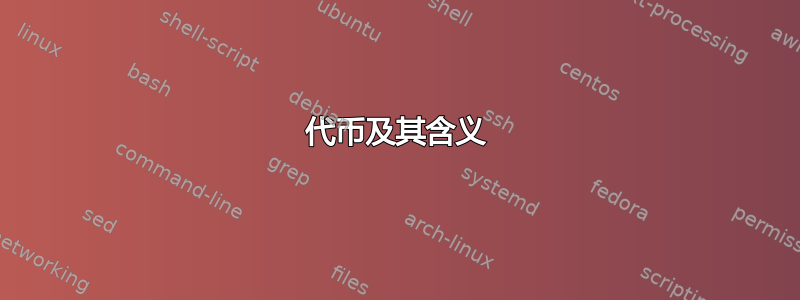
在tikz 声明函数和 babel 法语选项它涉及到 TeX 含义中局部和全局之间的区别的问题。
在链接的问题中,;应该在 a 中停用babel 简写{tikzpicture},这可以通过以下方式完成
\begin{tikzpicture}
\shorthandoff{;}
...
\end{tikzpicture}
答案1
概念全球的和当地的与为标记分配含义或为寄存器分配值有关。
代币及其含义
标记是 TeX 的基本食物,有两种:字符标记和象征性标记粗略的说,后者就是我们用“反斜杠+字符”来表示的。
字符标记的含义取决于该字符的“字符代码”和“类别代码”的组合;例如,在正常设置下,字符A对应于对 (65,11),而{对应于对 (123,1)。类别代码 1 赋予{其作为组和参数分隔符的特殊含义。类似地,\对应于 (92,0),因此反斜杠充当符号标记的标记。
许多代币都有预定义意思是 TeX 开始工作的时候。每个字符标记都有一个字符代码(不能更改)和一个类别代码(可以稍后更改);一些符号标记是原始,这样 TeX 就不会从零开始。
作业
任何时候,都可以为新的符号标记赋予含义,或者可以更改已知标记的含义(对于字符标记,仅更改类别代码)。TeX 对标记的操作取决于上下文。例如,\tracingmacros是一个(原始)整数寄存器;
\tracingmacros=1
TeX 将分配将值 1 存入整数寄存器,而
\count255=\tracingmacros
存储的当前值\tracingmacros将被赋值为存储在整数寄存器中的值\count255。
两者都是作业每次修改存储在寄存器或数组中的标记或值的含义时,我们都在进行赋值。列出所有类型的赋值会太长。除了前面显示的类型外,基本类型还包括:
\def\cs<parameter text>{<replacement text>}
\let\cs=<token>
\catcode<8 bit number>=<4 bit number>
<font selector>
(当使用 LuaTeX 或 XeTeX 时, 为<8 bit number>)<21 bit number>。最后一种类型表示选择字体作为当前字体的符号标记(当使用或 时,<font selector>LaTeX 会在后台执行此类分配)。还有更多,但这样说太过分了。\bfseries\textit
准确地说,作业不能真正地完成任何\edef时间。TeX 仅在执行命令时才执行赋值(扩展宏时除外);特别是在计算替换文本时或写出操作结果时,它不会执行赋值\write。
活跃角色
字符标记的一种特殊类型是类别代码为 13 的标记。当 TeX 发现这样的字符时,它会将其视为符号标记来查找其含义,并且必须用\def或 (或其变体)来分配该含义\let。这是众所周知的 的情况~。
群组
按规定每一个赋值(几乎每个赋值,参见“例外”部分)都是有作用域的,当当前组结束。什么是组?TeX 可以通过多种方式打开组:
使用
{不具有参数分隔符作用的 ;该组将以}同一括号级别的 结尾。可以使用\bgroupfor{或\egroupfor}获得相同效果(简单组)。使用
\begingroup; 当前组将以相应的\endgroup(结束半单群)。\vbox当要排版为、\vtop或\vcenter的文本\hbox被吸收时(箱体组)。当对齐单元格的文本被吸收时;它几乎与框组相同(对齐组)。
当
$或$$启动数学公式时(数学公式组)。开始或结束数学显示的
标记$$由 LaTeX 自动提供;切勿$$...$$在 LaTeX 中直接使用其他特殊情况可以在 TeXbook 或 TeX by Topic 中找到(例如,
\left开始一个组,以匹配的 结束\right)。
因此\begingroup\tensl ABC \endgroup DEF将打印“ABCDEF”,因为当前字体的赋值在 时结束其生效\endgroup。相反
\def\my#1{-- #1 --}
\my{\tensl ABC} DEF
将打印“--ABC--防御“并继续使用倾斜的字体,因为\tensl在组内还未看到该声明。
全球任务
每个赋值都可以以 and 为前缀,在这种情况下,其效果将超越当前组。 is ; so\global的缩写\global\def\gdef
\begingroup
\catcode`-=\active % \active here means 13
\gdef-{not a hyphen}
\endgroup
同时显示两种分配方式。 的类别代码-仅在本地更改,但 的含义-作为活动字符被全局分配。每当 TeX 找到 (45,13) 对时, 的定义-将用作活动字符,但-在 之后将不再默认为活动字符\endgroup。稍后将对此进行详细介绍。
乳胶
在 LaTeX 中,什么才算是组?除了上述一般的 TeX 构造之外,环境也会形成组,这是因为 LaTeX 实现\begin和的方式不同\end,\begingroup前者和\endgroup后者都存在。但有一个明显的例外,即环境document,但这仅从理论角度来看很重要,因为只能有一个环境。但是,、、、、和的document参数也将被吸收为组,因为它们在内部使用、或。类似地,或环境中的每个单元格都会自己组成一个组,这是对齐组的特殊情况。\mbox\makebox\fbox\framebox\sbox\savebox\parbox\hbox\vbox\vtop\vcentertabulartabbing
LaTeX 命令\newcommand、、\renewcommand和\newenvironment是\renewenvironment的包装器\def,因此它们仅作用于本地,但不能以 开头\global。因此,除了使用较低级别的命令外,基本上没有办法在 LaTeX 中进行全局分配。LaTeX 的分配是一个例外计数器它们始终是全局的(见底部)。
法语分号的问题
为了应对法语排版的特殊性,babel将一些字符更改为类别代码 13(活动)。这可能会导致 TikZ 出现问题,因为它使用分号作为语句分隔符,但也使用冒号作为语法分隔符。TikZ 的开发人员已尽最大努力避免此设置出现问题,但有时可能会出错。
\usepackage[french]{babel}
具体做什么?细节相当复杂,但除其他事项外,基本上将执行以下操作(然而,这是一个非常广泛的简化):
\begingroup
\catcode`;=\active % \active here means 13
\gdef;{\unskip\penalty10000 \thinspace\string;}
\catcode`:=\active % \active here means 13
\gdef:{\unskip~\string:}
\endgroup
\AtBeginDocument{\catcode`;=\active \catcode`:=\active}
那么当;或:在文档中找到不是例如,TikZ 对语句分隔符的期望。
\documentclass{article}
\usepackage[french]{babel}
\usepackage{tikz}
\begin{document}
\begin{tikzpicture}
\tikzset{declare function={Carre(\t)=\t*\t;}}
\draw plot [domain=-1:1] (\x,{Carre(\x)});
\end{tikzpicture}
\end{document}
语句分隔符的分号\draw被正确解释,因为 TikZ 知道在这种情况下如何处理活动分号。但语句分隔符\tikzset被视为这样却为时已晚。
为了解决这个问题,有两种方法:
将
\tikzset声明放在序言中,其中分号不是积极的。使用本地赋值使分号在
tikzpicture环境中处于非活动状态
因此
\documentclass{article}
\usepackage[french]{babel}
\usepackage{tikz}
\tikzset{declare function={Carre(\t)=\t*\t;}}
\begin{document}
\begin{tikzpicture}
\draw plot [domain=-1:1] (\x,{Carre(\x)});
\end{tikzpicture}
\end{document}
和
\documentclass{article}
\usepackage[french]{babel}
\usepackage{tikz}
\begin{document}
\begin{tikzpicture}
\shorthandoff{;}
\tikzset{declare function={Carre(\t)=\t*\t;}}
\draw plot [domain=-1:1] (\x,{Carre(\x)});
\end{tikzpicture}
\end{document}
可以工作;\shorthandoff{;}这是 Babel 在本地关闭字符标记活动特性的方式,基本上意味着
\catcode`;=<whatever category code ; had at the start of the job>
而不必强迫我们知道要使用的代码是 12。由于分配是本地的,它将在 结束\end{tikzpicture},因此此后该字符;将再次处于活动状态。
随着 TikZ 3.00 版本的推出,该babel库已被引入,因此当
\usetikzlibrary{babel}
用来。(添加于 2015-01-02)
本地分配的其他用途
假设有人希望除了“一般”定理之外,还有“命名定理”。例如,在某人写的书中,计划有
秩零定理 1.4
格拉姆-施密特定理 2.3
在其他明确标记的声明中定理。一种策略是为每个名称定义一个新的类定理环境,与普通theorem环境共享计数器。不过,可以做得更好:
\newtheorem{theorem}{Theorem}[chapter]
\newtheorem{namedtheoremaux}[theorem]{\protect\thistheoremname}
\newcommand{\thistheoremname}{}
\newenvironment{namedtheorem}[1]
{\renewcommand{\thistheoremname}{#1}\begin{namedtheoremaux}}
{\end{namedtheoremaux}}
这样输入就可以
\begin{namedtheorem}{Rank-nullity theorem}
...
\end{namedtheorem}
...
\begin{namedtheorem}{Gram-Schmidt theorem}
...
\end{namedtheorem}
定义中的对于LaTeX 的标准或 提供的标准\protect来说不是必需的;它是用于并且 否则不会造成任何损害。\newtheoremamsthmntheorem
的重新定义\thistheoremname是局部的,因此它只会影响当前namedtheorem环境。
例外
TeX 所做的一些分配是本质上是全球性的. 最常用的此类任务是
\hyphenchar\font=`-
\hyphenchar\font=-1
第一个告诉 TeX,在当前字体中排版时用作连字符的字符应该是普通连字符;第二个告诉 TeX,此字体的连字符被抑制。
说出来不是个好主意
This is a normal paragraph and the following word must not be
{\hyphenchar\font=-1 hyphenated} but others can
因为不段落中以及后面使用相同字体的单词将被连字符连接,因为即使前面没有 ,分配也是全局的\global;然而
This is a normal paragraph and the following word must not be
\hyphenchar\font=-1 hyphenated \hyphenchar\font=`- but others can
也不起作用,因为 TeX 对一个字体仅使用一个连字符,即段落结束时与之关联的连字符。
再次使用 LaTeX
计数器上的 LaTeX 操作
\setcounter\addtocounter\stepcounter和\refstepcounter
实现为全球的作业。相反,\setlength在本地操作(并且在其前面加上\global不起作用)。
答案2
Tobi 的回答并不准确。
你\shorthandsoff{;}真的不重新定义 ;,你将 catcode 更改为 ,;以便active它other里面根本tikzpicture不会执行。
这意味着tikzpicture它在内部可以正常工作,但在内部\textbf{...}(或任何其他接受参数的命令)则不行。这是因为字符是在读取时使用 catcode 读取的,而不是在执行时。另一方面,宏赋值( \def、\newcommand、 、 ...)是在执行时完成的,因此即使在宏参数中也能正常工作。\let
请注意,如果命令没有将其参数括在组中( 、\begingroup...\endgroup或{...})\bgroup...\egroup,则不会使赋值“在参数内部局部化”,而是“在宏的范围内局部化”。请参阅以下示例:
\newcommand\mparen[1]{(#1)}
\def\A{a}
\textbf{\A\ \def\A{b}\A}\ \A % result: a b a
\mparen{\A\ \def\A{b}\A}\ \A % result: a b b
因此,最好在定义中添加分组\mparen:
\newcommand\mparen[1]{({#1})}
最后一条注释展示了 catcode 赋值与宏赋值的区别。该命令\makeatletter会赋值@一个 catcode letter,以便可以在宏名称中使用它。该命令\makeatother会还原此操作。因此,请尝试以下示例:
\makeatletter
\newcommand\mparen[1]{(#1)}
\def\A{a}
\def\A@B{b}
\makeatother
\begin{bfseries}
\makeatletter
\A\ \A@B % result: a b
\end{bfseries}
\A\ \A@B % result: a a@B
\textbf{\makeatletter \A\ \A@B}% result: a a@B
\A\ \A@B % result: a a@B
\mparen{\makeatletter \A\ \A@B}% result: a a@B
\A\ \A@B % result: a b
我被要求解释一下最后三行发生了什么。我会一步一步地解释。我r:标记了 TeXReads。o: 我标记的是哦输出并处理。m:我标记了宏的含义
r: \A
m: \A -> a
r: a % we now read the definition of \A
o: letter `a`
r: \
o: space
r: \A % remember, @ is not a letter
m: \A -> a
r: a
o: letter `a`
r: @
o: symbol `@`
r: B
o: letter `B`
r: empty line
o: end of paragraph
r: \mparen
m: \mparen#1 -> (#1)
r: {\makeatletter \A\ \A@B} % at this moment, TeX core reads
% the arguments. Since @ is still not a letter, sequence \A@B
% comprises three tokens, `\A` `@` `B`
r: (
o: symbol `(`
r: #1
r: \makeatletter
o: change of catcode of `@` % notice we ARE NOT IN A GROUP
r: \A
m: \A -> a
r: a
o: letter `a`
r: \
o: space
r: \A
m: \A -> a
r: a
o: letter `a`
r: @ % catcode is now "letter", but it was actually read
% couple steps before where catcode was "other"
o: symbol `@`
r: B
o: letter `B`
r: )
o: symbol `)`
r: empty line
o: end of paragraph
r: \A
m: \A -> a
r: a
o: letter `a`
r: \
o: space
r: \A@B % catcode of @ is "letter" now so it's treatened as a part
% of macro name
m: \A@B -> b
r: b
o: letter `b`
答案3
在 TeX 中,每个赋值(定义、计数器更改、catcode 更改等)都是本地的,即,它的作用域位于所谓的“组”内,除非明确将其设为全局。组是两个括号之间的所有内容,即
outside {inside} outside
(括号中括号界定参数的情况除外),环境中的所有内容,即
outside
\begin{env}
inside
\end{env}
outside
或介于\begingroup和之间的任意值\endgroup,
outside
\begingroup
inside
\endgroup
outside
后者在\begin#1和的定义中使用\end#1。
举个例子可以说明:
\documentclass{article}
\newcommand{\A}{A}
\begin{document}
\A\ expands to A
\begin{center}
\A\ expands to A \\
\renewcommand{\A}{AA}
\A\ expands to AA
\newcommand{\B}{B}
\B\ expands to B
\end{center}
\A\ expands to A and not AA!
\B\ is undefined outside the group here
\end{document}
它的实际用途是保持定义的改变在本地,或者,例如,设置某些单词的字体,如normal {\tiny tiny} normal。
问题在于
\begin{tikzpicture}
\shorthandoff{;}
...
\end{tikzpicture}
是必须添加\shorthandoff在每个{tikzpicture}因为它是停用的(即 catcode 更改,请参阅tohecz 答案) 保持在当前 的本地{tikzpicture}。当然,可以将 添加\shorthandoff到前言中,但随后也会切换到普通文本。可以使用 ' 将停用宏添加到 的\begin{tikzpicture}定义etoolbox中\AtBeginEnvironment
\AtBeginEnvironment{tikzpicture}{\shorthandoff{;}}
或者在这种情况下使用 TikZ 风格,就像 Jake 说的:
\tikzset{
every picture/.prefix style={
execute at begin picture=\shorthandoff{;}
}
}


